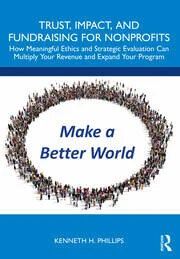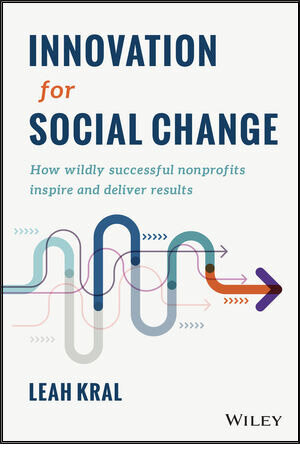How to Save the World in Six (Not So Easy) Steps: Bringing Out the Best in Nonprofits
At the center of David M. Schizer’s How to Save the World in Six (Not So Easy) Steps: Bringing Out the Best in Nonprofits is a buoyant, decidedly optimistic, and distinctively American belief that we can make the world a better place. For Schizer, former dean of Columbia Law School, former CEO of the American Jewish Joint Distribution Committee, and the grandson of a Ukrainian immigrant who taught himself English at the public library, the work of nonprofits large and small is the very lifeblood of the American experience in all its messy diversity and complexity. But to get to that better place, nonprofits—and the people who run them—need to dig deep, be intentionally introspective, and embrace change.
Faced with the sheer size of the U.S. social sector, Schizer is at once inspired by all the good that nonprofits accomplish—often with limited dollars—but equally frustrated by the mediocrity that he sees as pervasive across the sector.
Schizer hastens to remind us of how encompassing the nonprofit sector is to the fabric of American social and economic life. Most Americans are born in and will die in nonprofit hospitals, be educated at nonprofit universities, worship in nonprofit churches, and rely on a myriad of nonprofit organizations to help them organize their political, social, and cultural energies to address pressing issues across their lifetimes. Even when government seems paralyzed by political division and unable to address urgent issues, U.S.-based nonprofits—all 1.5 million of them—serve to frame our values and elevate the causes we see as important, whether that is supporting the arts, mitigating climate change, reducing income inequality, advancing racial justice, ensuring access to mental health care, or preventing gun violence. All told, American nonprofits spend $2.5 trillion annually, just about 10 percent of U.S. gross domestic product (GDP) and more than the entire GDP of Canada.
Faced with the sheer size of the U.S. social sector, Schizer is at once inspired by all the good that nonprofits accomplish—often with limited dollars—but equally frustrated by the mediocrity that he sees as pervasive across the sector. In his estimation, “too many nonprofits don’t advance their mission effectively. They deliver subpar results, are stuck in their ways, or are wracked with infighting.” After a quarter-century of managing major nonprofits, Schizer is acutely aware of what does and does not work. How to Save the World is a field manual designed to help nonprofits “figure out what to do, while also getting everyone on board to do it.”
Schizer’s investigation identifies, as the title suggests, six core actions that any nonprofit should embrace if it wants to achieve its mission and remain relevant and effective over the long term. His alliterative list of “not so easy” steps include plan, persevere, prioritize, pivot, publicize, and partner—seemingly obvious but functionally critical tasks that Schizer outlines in individual chapters as a framework for developing, executing, and maintaining strategic success for any nonprofit of any size. They comprise, in fact, a complex and interrelated set of ongoing processes, conversations, and decisions that can help keep successful nonprofits nimble, adaptive, and dynamic. Equally important, Schizer’s framework can set ossified organizations free from hardened choices that prevent them from abandoning ineffective strategies, taking risks on innovative ideas, and seizing opportunities to break new ground.
To succeed, Schizer tells us, a nonprofit needs to rigorously plan for the near and the long term. A forward-looking strategy recognizes that conditions and needs change, as do the tools available to achieve goals and monitor progress. If a nonprofit is not planning for the future, especially in an era of exploding technological innovation, it is sure to settle into mediocrity. Successful planning requires seeking out expertise, evaluating programs, engaging with criticism, and setting an intentional pace for change—what Schizer describes as perseverance. When nonprofit leaders engage with their staff and board in planning for and executing change, the likelihood of success is magnified.
Successful planning requires seeking out expertise, evaluating their programming, engaging with criticism, and setting an intentional pace for change—what Schizer describes as perseverance.
So too, when nonprofits learn to prioritize they are able to create a clearly defined strategy to achieve the mission. In the absence of priorities, a strategy will invariably lack coherence and internal support and, as a result, fail to address the very challenge the nonprofit was purpose-built to address. For Schizer, there are no sacred cows, no practices or choices that cannot be challenged. To help nonprofits find and align their priorities, he tees up three vital questions for every nonprofit to consider: How important is the problem we are trying to solve? How effective is our response? And are we the right organization to respond? When a nonprofit engages these questions, however difficult that process may be, they can avoid critical mistakes and focus instead on their comparative advantages and capacity to do “socially valuable work that others can’t or won’t do as well.”
Essential to Schizer’s framework is the capacity of nonprofits to hold themselves accountable and pivot when strategies fail to achieve their desired outcomes. A successful nonprofit will embrace the notion that their efforts are—and should be—experiments, with results measured and opportunities to innovate built into the process. Equally important is the external conversation nonprofits need to have with their community, that is, to publicize their work, not as a celebration of a job well done but as part of a dialogue that deepens trust and helps the nonprofit improve and sharpen its priorities. Lastly, nonprofits must necessarily partner with members of their community, with peer organizations, and especially with their financial supporters. Nonprofits that fail to see donors as true collaborators and part of their community run the risk of losing their support.
Nonprofits, like people, have their strengths and weaknesses—what Schizer views as two sides of the same coin—creating mixed blessings that both inspire and frustrate those who fund a nonprofit, those who benefit from its efforts, and those who do the work of achieving its goals. A nonprofit’s mission is the key motivation for its success, but adherence to an outdated framing of a social challenge or an inflexible reaction to changing circumstances runs the risk of alienating the diverse communities a nonprofit aspires to serve. While nonprofits have the autonomy to operate outside of government or institutional walls, they also face the challenge of consistently measuring performance and run the risk that room to experiment might also lead to self-interested or misguided decisions.
A nonprofit’s mission is the key motivation for its success, but adherence to an outdated framing of a social challenge or an inflexible reaction to changing circumstances run the risk of alienating the diverse communities a nonprofit aspires to serve.
Schizer describes the current moment as the best of times and the worst of times for nonprofits. His is a warm and empathetic read of history, both that of his family, their long association with Columbia University and the Brooklyn Public Library—where his grandfather taught himself English and his father was a trustee and board chair—and more broadly of the work of the nonprofit sector and his hopes for its continued success. For America to succeed, for human beings to fully benefit from the technological innovations and social transformations of the last half-century, we need dynamic nonprofits that work effectively in the trenches and on the edges of our most intractable challenges. That means embracing a mindset that sees change not as a threat, but as an opportunity to adapt, transform, and intentionally reconsider the priorities and principles that drive nonprofit work. While Schizer’s prescription may not actually “save the world,” it surely will improve the performance of any nonprofit that takes that cause to heart. As Schizer tells us, “Good intentions aren’t enough. To add value, nonprofits need to be effective in advancing their missions. The point is not just to feel good but to do good.”
Daniel X Matz is contributing editor at Philanthropy News Digest.










